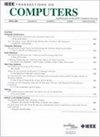面向高性能固态硬盘的机器学习驱动缓存管理方案
IF 3.6
2区 计算机科学
Q2 COMPUTER SCIENCE, HARDWARE & ARCHITECTURE
引用次数: 0
摘要
基于 NAND 闪存的固态硬盘(SSD)凭借其卓越的性能和低功耗,在数据存储领域得到了广泛应用。固态硬盘的计算能力得到了提升,可以处理复杂的算法。在固态硬盘中,用于频繁访问请求的 DRAM 缓存缩短了响应时间,降低了写放大(WA),从而提高了固态硬盘的性能和使用寿命。现有的缓存方案以时间定位为基础,忽略了其变化,这可能会降低缓存命中率。一些缓存方案通过闪存感知技术提高了性能,但却牺牲了缓存命中率。为了解决这些问题,我们提出了一种名为 CCache 的随机森林机器学习分类器授权缓存方案,根据访问状态将 I/O 请求分为关键请求、中间请求和非关键请求。在设计了一个机器学习模型来预测这三类请求后,我们实施了一个三级链表来管理缓存的放置和替换。CCache 最大程度地保障了关键请求的缓存服务,同时给予非关键请求访问的请求驱逐最高优先级。在处理非关键请求时考虑芯片状态的 CCache 是在固态硬盘模拟器(SSDSim)中实现的。就响应时间、WA、擦除次数和命中率而言,CCache优于其他缓存方案,包括LRU、CFLRU、LCR、NCache、ML_WP和CCache_ANN。CCache 和 OPT 方案之间的性能差异很小。例如,CCache 可将竞争对手的响应时间缩短 41.9%,平均缩短 16.1%。CCache 最多可将擦除次数减少 67.4%,平均为 21.3%。CCache 与 OPT 之间的性能差距仅为 2.0%-3.0%。本文章由计算机程序翻译,如有差异,请以英文原文为准。
A Machine Learning-Empowered Cache Management Scheme for High-Performance SSDs
NAND Flash-based solid-state drives (SSDs) have gained widespread usage in data storage thanks to their exceptional performance and low power consumption. The computational capability of SSDs has been elevated to tackle complex algorithms. Inside an SSD, a DRAM cache for frequently accessed requests reduces response time and write amplification (WA), thereby improving SSD performance and lifetime. Existing caching schemes, based on temporal locality, overlook its variations, which potentially reduces cache hit rates. Some caching schemes bolster performance via flash-aware techniques but at the expense of the cache hit rate. To address these issues, we propose a random forest machine learning
C
lassifier-empowered
C
ache scheme named CCache, where I/O requests are classified into critical, intermediate, and non-critical ones according to their access status. After designing a machine learning model to predict these three types of requests, we implement a trie-level linked list to manage the cache placement and replacement. CCache safeguards critical requests for cache service to the greatest extent, while granting the highest priority to evicting request accessed by non-critical requests. CCache – considering chip state when processing non-critical requests – is implemented in an SSD simulator (SSDSim). CCache outperforms the alternative caching schemes, including LRU, CFLRU, LCR, NCache, ML_WP, and CCache_ANN, in terms of response time, WA, erase count, and hit ratio. The performance discrepancy between CCache and the OPT scheme is marginal. For example, CCache reduces the response time of the competitors by up to 41.9% with an average of 16.1%. CCache slashes erase counts by a maximum of 67.4%, with an average of 21.3%. The performance gap between CCache and and OPT is merely 2.0%-3.0%.
求助全文
通过发布文献求助,成功后即可免费获取论文全文。
去求助
来源期刊

IEEE Transactions on Computers
工程技术-工程:电子与电气
CiteScore
6.60
自引率
5.40%
发文量
199
审稿时长
6.0 months
期刊介绍:
The IEEE Transactions on Computers is a monthly publication with a wide distribution to researchers, developers, technical managers, and educators in the computer field. It publishes papers on research in areas of current interest to the readers. These areas include, but are not limited to, the following: a) computer organizations and architectures; b) operating systems, software systems, and communication protocols; c) real-time systems and embedded systems; d) digital devices, computer components, and interconnection networks; e) specification, design, prototyping, and testing methods and tools; f) performance, fault tolerance, reliability, security, and testability; g) case studies and experimental and theoretical evaluations; and h) new and important applications and trends.
 求助内容:
求助内容: 应助结果提醒方式:
应助结果提醒方式:


